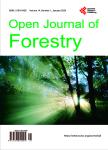Field Performance of Quercus bicolor Established as Repeatedly Air-Root-Pruned Container and Bareroot Planting Stock
Field Performance of Quercus bicolor Established as Repeatedly Air-Root-Pruned Container and Bareroot Planting Stock作者机构:Northern Research Station USDA Forest Service University of Missouri Columbia MO USA Missouri Valley College Marshall MO USA formerly Center for Agroforestry University of Missouri Columbia MO USA College of Agriculture Food and Natural Resources University of Missouri Columbia MO USA Center for Agroforestry University of Missouri Columbia MO USA Department of Forestry University of Missouri Columbia MO USA
出 版 物:《Open Journal of Forestry》 (林学期刊(英文))
年 卷 期:2016年第6卷第3期
页 面:163-176页
学科分类:0907[农学-林学] 08[工学] 0829[工学-林业工程] 09[农学]
主 题:Afforestation Root Fibrosity Root Production Method Seedling Quality Swamp White Oak Whole-Tree Biomass
摘 要:Benefits of repeated air-root-pruning of seedlings when stepping up to progressively larger containers include excellent lateral root distribution immediately below the root collar and an exceptionally fibrous root ball. To evaluate long-term field performance of repeatedly air-root-pruned container stock, three plantings of swamp white oak (Quercus bicolor Willd.) 10 to 13 years old were located that also included bareroot planting stock. Initial and final stem diameter and height and above-ground green weights were determined on randomly selected trees at each site. On a site with a sandy, excessively drained, high pH soil, trees (age 10) from container stock were 1.5 times taller, 2.3 times larger in dbh, and 2.8 times greater in green weight than trees from bareroot stock which averaged only 2.9 m tall, 3.9 cm dbh, and 16.3 kg green weight. On a site with high clay, poor internal drainage, and frequent flooding, trees (age 12) from container stock were 1.4 times taller, 1.8 times larger in dbh, and 4.1 times greater in green weight than trees from bareroot stock which averaged 4 m tall, 7.3 cm dbh, and 28 kg green weight. On an upland site with deep loess soils, there was a trend for trees (age 13) from container stock to be only slightly larger than trees from bareroot stock with each stock type averaging 9.6 m tall, 20 cm dbh, and 177 kg green weight. Repeated air-root pruning produced lateral roots immediately below the root collar that resulted in large container stock with large well-balanced root systems that were competitive on harsh or less than ideal oak sites. Although the process is relatively labor intensive, propagation of repeatedly air-root-pruned container stock is readily adaptable internationally to locally available sources of organic matter and open-bottom containers.



